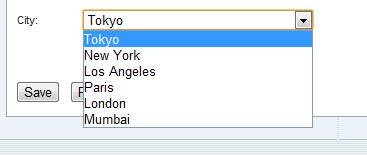
Drop down boxes allow administrators to allow users to choose from a known set of available values. It is very helpful to control the way users input information, particularly if the attribute has a known and limited set of valid values. For example, if your organization only has offices in 6 cities, you may want to restrict them to these 6 values so you do not get variations of spellings and other names entered.
In this example, the administrator can create a drop down box for City with a set of cities. To do this, you would input the following:

The user would see the following drop down:

SMOD also supports a mapping feature so that the value displayed to the user and the value written to Active Directory are different. This is done by the following format:
<DISPLAY VALUE1>^<VALUE TO WRITE1>|<DISPLAY VALUE2>^<VALUE TO WRITE2>|<DISPLAY VALUE3>^<VALUE TO WRITE3> ETC
For example, if you want to accomplish the following:
| What to display to the user | What to write to Active Directory |
| Sales | 001 |
| Marketing | 002 |
| Engineering | 003 |
| Accounting | 004 |
In the value field for the attribute, you would put the following:
Sales^001|Marketing^002|Engineering^003|Accounting^004
This feature of SMOD is commonly used for State abbreviations, country codes, code pages.
In general, you may want to give the user a choice to have a blank entry. To do this, the first value should be pre-pended with "|". For example, to create a drop down box that looks like this:

You would enter the following in the value field for this attribute:
|Dallas|Houston|San Antonio